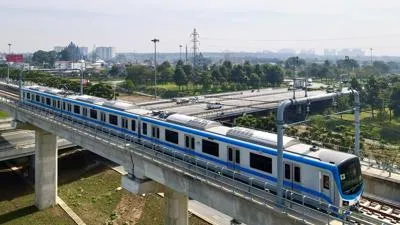
This impending development signifies the imminent realization of a modern urban railway construction project after more than two decades of patient anticipation. The narrative surrounding the delays in the implementation of the first metro line in the largest urban center in the South prompts contemplation on traffic development strategies for densely populated cities in Vietnam.
For the past two decades, the Ben Thanh - Suoi Tien metro project No. 1 has been a source of great anticipation and, at times, anxiety. Spanning 19.7 kilometers from Ben Thanh station (District 1) to Long Binh depot (Thu Duc City), the metro line required a total adjusted investment of VND 43,700 billion. Comprising 17 trains with 51 carriages, manufactured by Japan's Hitachi, each train features three carriages, each measuring 61.5 meters in length and accommodating 930 passengers (147 sitting passengers and 783 standing passengers).
The prolonged 20-year timeline for completing the first metro line in Ho Chi Minh City can be attributed to a process entrenched in centralized, planned economic thinking. Delays occurred as each stage had to wait for various departments, branches, and localities to complete necessary procedures and adjustments before moving forward with implementation. This fragmented approach diverted attention and resources from the core construction of the project, resulting in the need for ongoing adjustments, numerous challenges, and a lack of connectivity between the transport infrastructure and adjacent urban areas.
The delays experienced by metro line No. 1 Ben Thanh - Suoi Tien highlight the need to adopt a market-economic approach for metro construction projects. This involves leveraging available land resources and mobilizing investment from social sources. It requires a comprehensive consideration of surrounding factors, compatibility with existing infrastructure and urban areas, as well as the integration of public services into the project planning process.
Experts emphasize that the sluggish progress of metro line No. 1 serves as a valuable learning experience, shedding light on the obstacles and challenges inherent in undertaking such projects. Moving forward, there is a pressing need for innovative thinking and methodologies to effectively harness resources and implement the specific mechanisms and policies outlined in Resolution 98. By embracing these lessons, future metro constructions can strive for greater efficiency and timely completion.
The bustling urban areas of Hanoi and Ho Chi Minh City collectively incur annual losses estimated at 2-3 billion USD due to traffic congestion. Consequently, the imperative of urban railway development becomes evident, as urban railway networks stand as the backbone of transportation systems in many global cities. These networks play a crucial role in alleviating congestion, reducing traffic accidents, and mitigating environmental pollution.
However, it's essential to acknowledge that urban railway construction projects necessitate substantial investment capital. Any delays at various stages of these projects can have cascading effects, impacting the overall progress and generating unfavorable consequences for the community at large. Recognizing the economic and societal costs of congestion, the focus on advancing and efficiently executing urban railway development becomes paramount for fostering sustainable and thriving urban environments.
At the conclusion of February 2024, the Politburo released Conclusion No. 72-KL/TW, emphasizing the ongoing implementation of Resolution No. 13-NQ/TW, dated January 16, 2012, issued by the 11th Party Central Committee. This resolution outlines the strategic vision of constructing comprehensive infrastructure to fundamentally transform the nation into a modern industrialized country.
The Ministry of Transport recently presented a proposal to the Prime Minister, outlining a plan to establish a Working Group tasked with overseeing the advancement of urban railway projects in Hanoi and Ho Chi Minh City. Deputy Prime Minister Tran Hong Ha is set to lead the working group, with two deputy heads: Chairman of Hanoi People's Committee Tran Sy Thanh and Chairman of Ho Chi Minh City People's Committee Phan Van Mai. This working group aims to assist the Prime Minister in directing, expediting, and reviewing relevant ministries, sectors, and agencies in addressing critical interdisciplinary issues. Its responsibilities include addressing challenges, removing obstacles, and promptly implementing mechanisms to ensure the progress of the projects.
Urban railways are widely acknowledged and implemented in many countries globally. While the necessity of urban railways is indisputable, the key challenge lies in finding viable solutions. In an ironic twist, the budget, which may not be abundant, is often directed towards airport construction projects in various localities rather than prioritizing urban railways. Although Ho Chi Minh City recognizes the significance of urban railways, it encounters numerous difficulties during the implementation process.
Ho Chi Minh City envisions a comprehensive plan comprising eight metro lines and three ground tram lines (monorail), with a total length of about 220 km and an estimated investment capital of 25 billion USD. Currently, metro line No. 1 Ben Thanh - Suoi Tien is considered temporarily stable, while metro line No. 2 Ben Thanh - Tham Luong, spanning over 30 km, is in progress with official development assistance (ODA) capital allocated through the central budget mechanism. However, the remaining routes are yet to receive investment. This highlights the ongoing challenges in realizing the full scope of Ho Chi Minh City's urban railway ambitions.
Achieving the ambitious target of 220 km of urban railways by 2035 in Ho Chi Minh City requires a fresh approach, as emphasized by architect Ngo Viet Nam Son. He highlights that the primary challenge lies in establishing an appropriate management structure and operating mechanism. To address this, he proposes the creation of a multi-industry complex, specifically an urban railway corporation. This would represent a departure from the existing project management boards under the Ho Chi Minh City People's Committee.
The envisioned urban railway corporation is designed to revolutionize management methods across planning, finance, construction, and the operation of metro lines. Unlike the current urban railway management board, which focuses primarily on project implementation, this proposed complex would play a more integral role in managing a large-scale public transport model. This innovative approach is seen as crucial for overcoming the existing challenges and realizing the comprehensive development of metro and public transport models in the city.




















